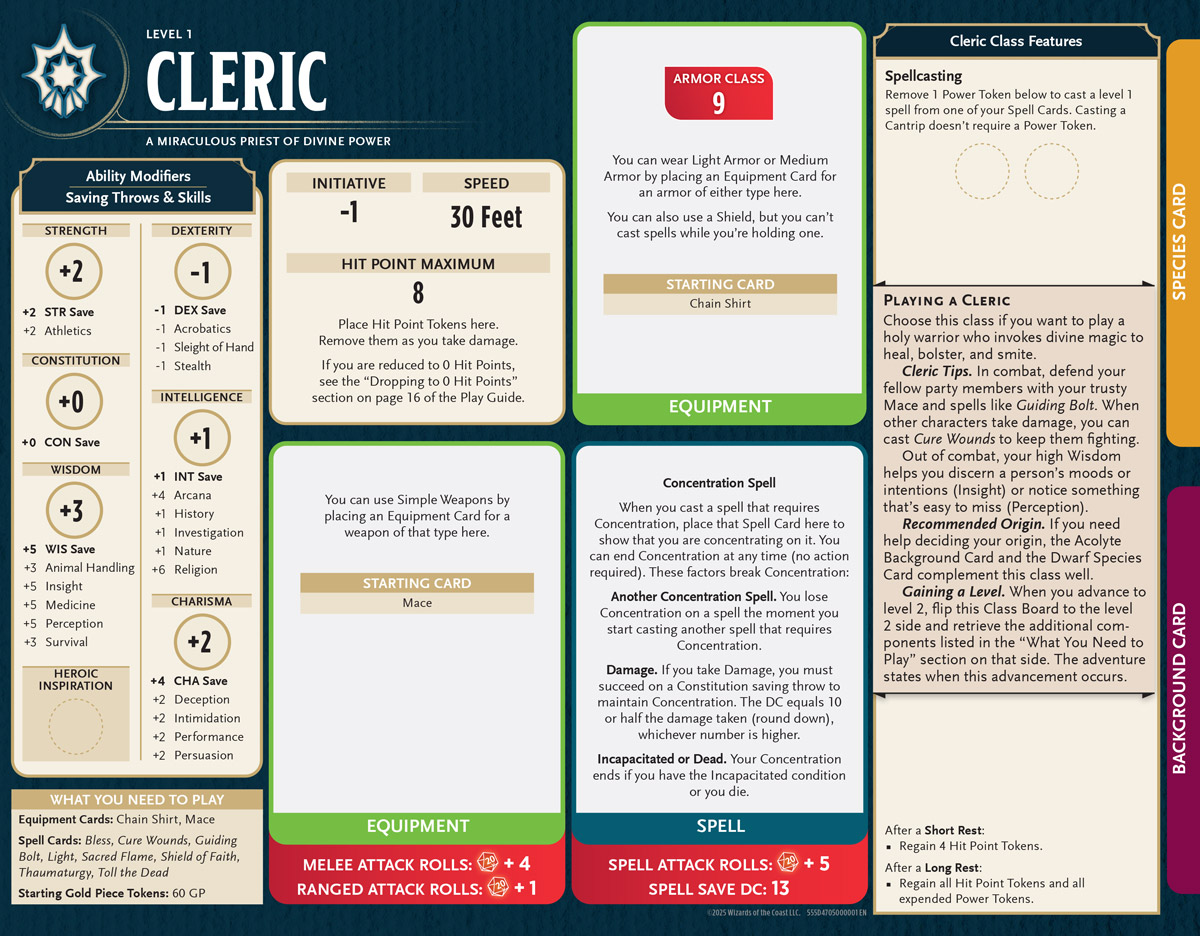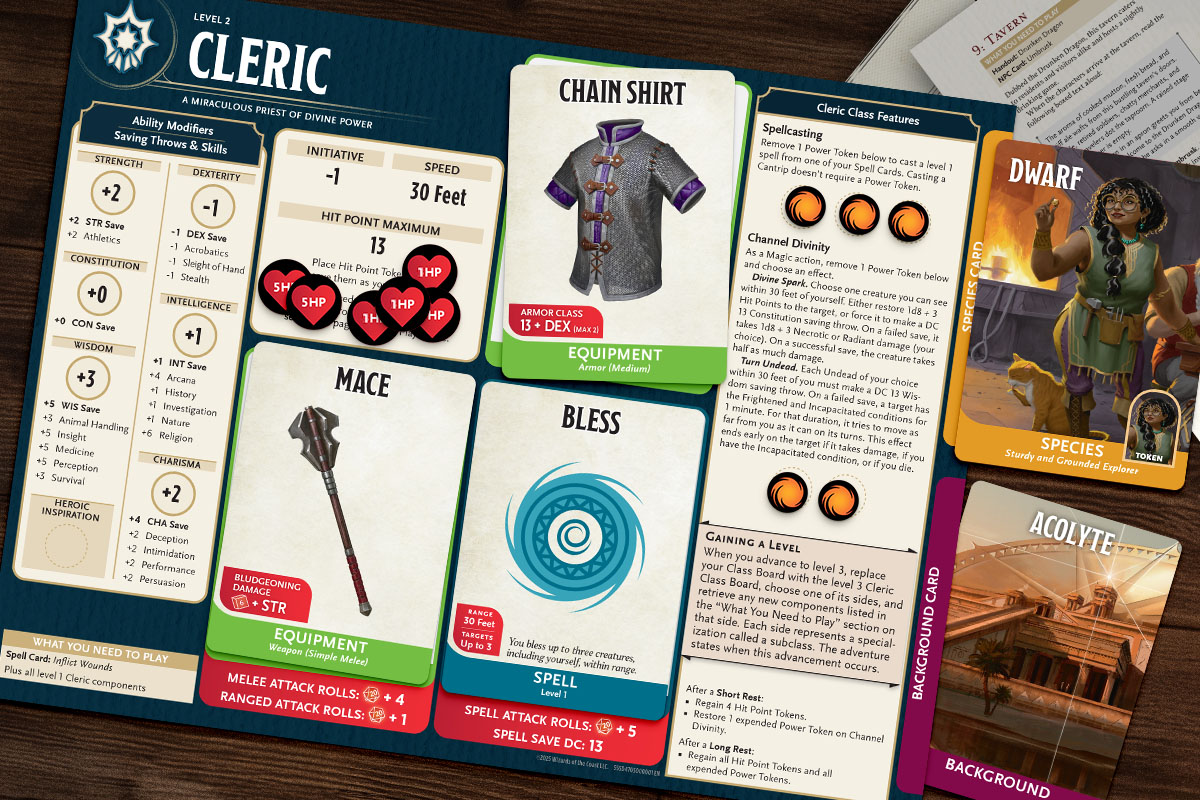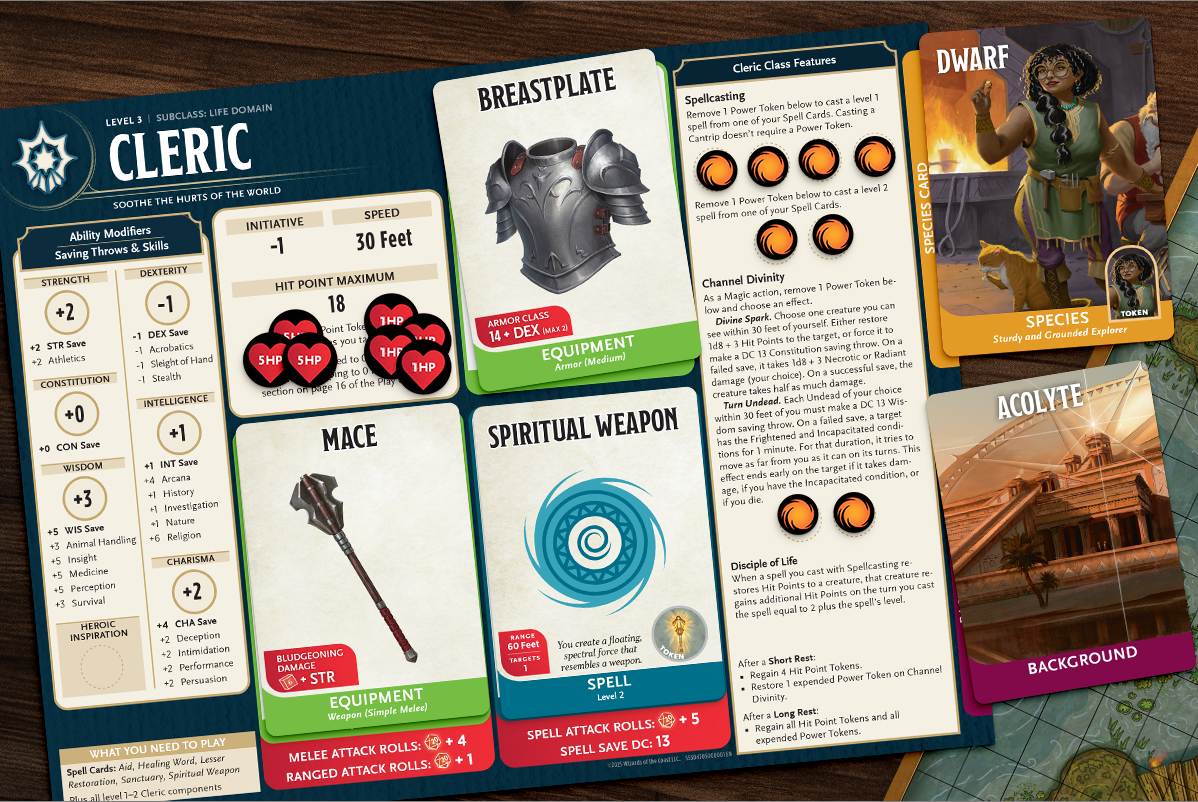When you open the Heroes of the Borderlands box, one of the first treasures you'll discover are the class boards. These are your gateway into the role of a hero, designed to combine the imagination of Dungeons & Dragons with the ease of use of a board game. Each board is a dashboard that clearly lays out everything you need to play, from your Armor Class to your spells and features, with card slots and token trackers that keep the game moving fast.
Let's explore how these boards make introducing new players to D&D smoother, faster, and more fun than ever before!
The Anatomy of a Class Board

Every class in Heroes of the Borderlands has its own board, but they share a similar layout so that new players can quickly find what matters. Let's break down the core sections:
Everything You Need to Get Rolling on Adventures
Each board is built so you can sit down, sort out a few cards, and start adventuring. The essential rules of your class are presented front and center, while the gear and gold you start with are listed in a tidy checklist.
- Ability Modifiers. The six core abilities—Strength, Dexterity, Constitution, Intelligence, Wisdom, and Charisma—dictate your character's strengths. Modifiers are pre-calculated and printed, so you can jump right into play with everything you need to make checks, saves, and attacks with zero prep.
- Saving Throws and Skills. These sections seamlessly include your proficiencies to highlight where your hero shines.
- What You Need to Play. This checklist shows which cards and tokens you'll need for your class. For example, the Cleric begins with a Chain Shirt, a Mace, a suite of staple spells like Bless and Cure Wounds, and 60 GP.
- Playing Your Class. You'll also receive guidance on both the fantasy of the class and the strategy behind it. This includes recommended origin cards to help streamline character creation as much as possible.
Combat and Class Features at a Glance
When it's time to draw steel or let spells fly, you won't need to go flipping through pages—everything you need to know about what your character can do is laid out in front of you.
- Initiative, Speed, and Hit Points. These trackers streamline combat. Tokens for Hit Points are a physical component, so losing tokens feels more like your character is fighting to stay standing.
- Attacking. Need to cast an offensive spell or swing your sword? Everything you need is prominently displayed alongside an icon for which dice you need to roll.
- Card Spaces. Clearly marked slots show where to place armor, origin, spell, and weapon cards. This keeps your table neat and helps you understand where your abilities are coming from and how to use them.
Bite-Sized Learning
Veteran D&D players will notice that these class boards slightly bend character creation and play rules to skirt around the more in-the-weeds details. This is done intentionally to help make onboarding as straightforward as possible.
For instance, you'll see that the section on Short Rest doesn't say anything about rolling Hit Point Dice; just that the character automatically receives 4 Hit Points after a Short Rest.
Similarly, the board doesn't mess around with describing components and weapon juggling to cast spells. It simply states, "You can also use a Shield, but you can't cast spells while you're holding one."
Growing with Your Hero
These boards evolve with your character. As you level up, discover new gear, and grow your abilities, your play surface changes in ways you can feel.
Level 2: A Burgeoning Hero

Each character's starting board is double-sided. When you level up to level 2, you flip the board over. The reverse side updates your Hit Points, adds new features, and expands your options without adding complexity. It's a smooth, tactile way to mark your growth.
Level 3: Specializing Your Role

At level 3, you swap your board for one tailored to your subclass choice. For the Cleric, you choose between the Life Domain and the Light Domain. The Life board emphasizes healing, durability, and protection, while the Light board unlocks radiant power and fiery spells that burn away the dark.
Every character receives new and unique powers at this milestone, and the boards reflect that choice clearly with new spells or subclass features printed right where you need them.
Designed for Play, Not Paperwork
These boards serve as an introduction to what used to be an intimidating character sheet with an easy-to-read play surface. Tokens, cards, and dedicated spaces all work together like a living rulebook and prepare players for the experience of a full character sheet when they're ready.
For new players, this means Heroes of the Borderlands can enable faster learning and more fun. For veterans, it means more friends and family members to play with, fewer interrupting rule lookups, and more time telling stories!

Mike Bernier is the founder of Arcane Eye, a site focused on providing useful tips and tricks to all those involved in the world of D&D. Outside of writing for Arcane Eye, Mike spends most of his time playing games, hiking with his partner, and tending the veritable jungle of houseplants that have invaded his house.








-
View User Profile
-
Send Message
Posted Sep 4, 2025Why would they change the rules, when the set is designed to introduce people to those rules? Nothing in this says it's meant to be independent, and they wouldn't want that. So yeah, it would 100% have a mandate to follow the D&D rules, because that's what they're trying to do. This is a "Starter" set, not an isolated board game. It's designed to teach people the basics of the game, and encourage them to buy the PHB. If they do that and find the rules are completely different, that would be jarring and people would be put off.
The adventures are apparently short enough to be run in an hour or so using pre-gen characters and the four classes, but it's not trying to be anything but the real game with aids to understanding.
-
View User Profile
-
Send Message
Posted Sep 4, 2025I fully agree with you that it is the intent of this set (and said as much in the quoted post). As for my own preferences, it's just a different design goal that obviously they don't share. The classic starters referenced (B/X and BECMI) were actually simplified versions of the then mainline "Advanced" D&D rules meant to give people an easier less complicated entry point into the ttrpg hobby in general and D&D in particular. I was simply hoping for something along those lines though I fully understand why they didn't. There has been a general overall trend in the industry towards rules light(er) games over the past decade and I was hoping that the starter would scratch that itch especially as the core rules have gained crunch with the 2024 edition compared with 2014. There's absolutely nothing wrong with that added complexity (as someone who started with 3.x as my first edtion I used much more back in the day) but it's simply a preference. YMMV.
-
View User Profile
-
Send Message
Posted Sep 4, 2025With the number of different TTRPG systems out there now, trying to dumb down D&D seems like a losing strategy for WotC, because it will simply drive people to other games with less crunch. Teach them what they're going to get in the real game, or you risk making them wish for a different one.
-
View User Profile
-
Send Message
Posted Sep 4, 2025That definitely can happen. I buy both physical and digital copies of everything for that exact reason. I'm fortunate enough to work in RPA/data infrastructure design, so we do two things:
I've had to print sheets for a game only once in the last year of running 2 - 4 times per week. That's a pretty good record. The thing that has been really useful about the nightly snapshots comes when players can't remember how a character they don't play anymore was configured. There may have also been a situation where a character's body was discreetly looted by multiple people after it died, but later was recovered by the original player's new character who assumed all of the loot was there. It was complicated. 😂
On the less "middle-aged-data-nerd" side of things, services like WorldAnvil, Foundry, and others can also import characters and automatically keep the most recent version for you. Yeah, it's another service, but that's the nature of doing things digitally. A middle-ground may be to just have your players keep "minimal stats" that they can use if they need to switch to offline mode to play. Enough info to adventure (in post situations) can fix on a single sheet of paper, or even an index card. In extreme times, you could always see if Avrae is working because it can see your characters as well. When Maps has a funky update and we couldn't see roll histories without constantly refreshing, I used a discord channel for the roll log and it wasn't a terrible experience.
Where there's there''s a will, there's a game!
-
View User Profile
-
Send Message
Posted Sep 4, 2025so basically it's already made characters with no input from the players classic make a character what a ripoff
the 1 aspect of the game is making a player rolling dice to customize their character it's the most fundamental thing about the game and hasbro is throwing it out of the game
now I'm not going to be getting this for sure for part of the game mechanics is to make your own choice by dice or buy points for a truly character that's personally created with what the player wants not premade characters that's why most RPG games like elder scrolls, pillars of eternity, Pathfinder kingmaker and wrath of the righteous, & ttrpgs were made
-
View User Profile
-
Send Message
Posted Sep 4, 2025I really hate how they decided that the best way to introduce players to D&D is to give them a version with different rules. Are hit dice really that complicated? And why did they say, "You can't cast spells while holding a shield?" Weapon juggling is not complicated. It takes an action (typically) to cast a spell, so if you want to cast a spell, you stow your mace, and then draw it on your next turn if you want to cast a spell. Finally, why did they not use the name "spell slot?" That's just going to confuse people.
-
View User Profile
-
Send Message
Posted Sep 4, 2025This set isn't for existing players who know how to make a character. I 100% recommend that you don't buy it.
-
View User Profile
-
Send Message
Posted Sep 4, 2025And yet they set it in an updated version of an all-time favorite module. So, yeah, they want everyone possible to buy this... just like every product they create.
-
View User Profile
-
Send Message
Posted Sep 4, 2025A starter set isn't made for people who already have or are itching to learn advanced knowledge of game rules and terms; that's what buying the core books is for. It's made for people who are probably surprised to find out that dice come in funny sizes/shapes other than 6-siders and that "hit dice" isn't an unnecessarily aggressive euphemism for rolling them.
-
View User Profile
-
Send Message
Posted Sep 5, 2025I recently bought a copy of the WoC D&D Adventure Begins board game which I don’t think is still in production. It was a great way to introduce my kids into D&D. I’m pretty amused reading this article because it too used character boards that you could flip over to go to level 2 to simplify things and eliminate character sheets. My concern with this starter set is that it really should introduce you to the basic rules and this seems to be kind of a inspired by D&D sort of system similar to the board game for kids. I’ll start optimistic and as a parent this will probably be solid for me but if you have a group of adults who want to play D&D for the first time, it might make more sense to go with a short one shot and just jump in.